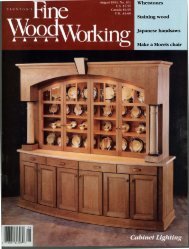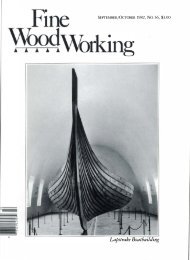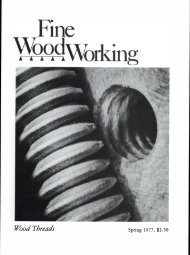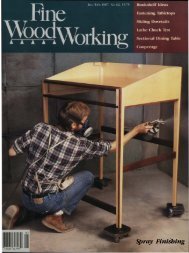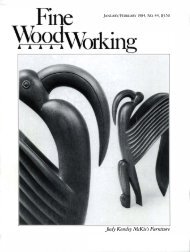NOVEMBER/DECEMBER 1983, No. 43, $3.50 Making ... - Wood Tools
NOVEMBER/DECEMBER 1983, No. 43, $3.50 Making ... - Wood Tools
NOVEMBER/DECEMBER 1983, No. 43, $3.50 Making ... - Wood Tools
You also want an ePaper? Increase the reach of your titles
YUMPU automatically turns print PDFs into web optimized ePapers that Google loves.
piece. Drying takes four to eight hours (depending on size) at<br />
200°F. Over 200°F causes too much internal checking; at<br />
400 ° F you get charcoal. Check dryness by rotating the tenon<br />
between your fingers: when it won't get any more oval, it's<br />
dry. With a little experience, you can turn juSt oversize<br />
enough so that joints will pop together (with a large hammer)<br />
with no further fitting. The larger diameter fits tight against<br />
the mortise end-grain; the smaller diameter is JUSt snug on the<br />
sides. For %-in. tenons, I allow %4 in. oversize (7Yz%). You<br />
can start there, and adjust for your woods and bits.<br />
For an angled joint, you can chamfer the shoulder of the<br />
tenon and one side of the mortise. Make the mortise extra<br />
deep so that the shoulder will seat. Shrinkage may open the<br />
joint a little, but it will still look good.<br />
The incredible duckbill spoon bit joint<br />
There is no one way to drill round holes<br />
in round sticks. I have used auger bits,<br />
Forstner bits, Power Bore bits, multispur<br />
bits and spade bits to make chair<br />
joints, and I have a few more ideas.<br />
Modern bits, however, have drawbacks.<br />
You don't want a leadscrew or a point<br />
projecting ahead of the cutting edge,<br />
where it will poke through the other<br />
side of the chair leg before the mortise is<br />
deep enough. You don't want a flatbottomed<br />
hole-because its bottom profile<br />
limits the size of the tenon, as explained<br />
below. <strong>No</strong>r do you even want<br />
the hole to be truly round, because an<br />
oval hole conforms better to the tenon.<br />
Chairmakers traditionally used the duckbill<br />
spoon bit, and its peculiar quirks<br />
combine to make the ideal mortise for<br />
green-wood chairs. The duckbill even<br />
turns the spoon bit's main shortcoming,<br />
boring slop, into a virtue.<br />
Disturbed<br />
grain<br />
...I-1rn- -End grain<br />
Long grain<br />
Spoon bits cut deeper in end grain<br />
than in long grain, producing an oval<br />
hole with characteristic tearout where<br />
the cutting edge makes the transition<br />
from a paring CUt to a scraping cut.<br />
Squarebottomed<br />
mortise<br />
Roundbottomed<br />
duckbill<br />
mortise<br />
Rounded corners in round stock make<br />
for a stronger chair. If the mortise were<br />
square-bottomed, both mortise and tenon<br />
would have to be smaller.<br />
72<br />
By canting the duckbill bit during<br />
boring, you can CUt the lower and upper<br />
walls of the mortise deeper, into a dovetail<br />
shape, without enlarging the opening<br />
or the sides.<br />
Tenons are turned green, then dried.<br />
The tenon shrinks to an oval cross-section<br />
during drying, which automatically<br />
helps it conform to the oval mortise. In<br />
side view, the tenon should be shaped to<br />
conform to the mortise's dovetail profile,<br />
so that it will bear tightly against<br />
the end grain in the leg. The end of the<br />
tenon is larger than the mortise opening,<br />
but the green wood in the chair leg is<br />
compressible enough that the tenon can<br />
be pounded home. The sides of the<br />
tenon are relieved, so as not to split the<br />
chair leg as it dries and shrinks.<br />
If a joint does not split when a tenon<br />
is pounded home, or very shortly thereafter,<br />
it is most unlikely to split later,<br />
unless the mortise is near the end of the<br />
stick. In a test piece, drive home a series<br />
of increasingly larger tenons until the leg<br />
splits, listening to the difference in<br />
sound as the peg seats. When it comes<br />
time to make the chair, drive home the<br />
size tenon just smaller than the one that<br />
split the mortise. One caution: Immediately<br />
after assembly, the dry tenon absorbs<br />
moisture from the green leg and<br />
swells, while the chair leg shrinks tighter<br />
against the sides until the leg is fully<br />
dry-if the sides of the tenon have not<br />
been relieved enough, the leg will split,<br />
starting in the areas of disturbed grain<br />
left by the spoon bit.<br />
The same process of green-turning and sand-drying works<br />
with tapered leg-to-seat joints. I ream the hole in an air-dried<br />
pine seat, then fit the tenon with a cabinetmakers' rasp. With<br />
the leg properly oriented (major diameter against end grain), I<br />
rotate<br />
FWW<br />
it back and forth a little. Then I file off the shiny spots,<br />
JUSt like lapping the valves in a car. Repeat this until the leg<br />
D<br />
feels really solid in the seat and is at the proper depth. Some<br />
angular correction is possible, and often needed.<br />
Dave Sawyer, the green-wood chairmaker featured in<br />
#33, was trained as a mechanical engineer and<br />
now makes Windsor chairs. You can get spoon bits from<br />
Conover <strong>Wood</strong>craft Specialties, 1nc., 18125 Madison Rd.,<br />
Parkman, Ohio 44080.<br />
by John D. Alexander<br />
With cyclical changes in humidiry,<br />
the mortise depth lengthens and shortens<br />
as the leg shrinks and expands. The<br />
length of the tenon, however, does not<br />
change. In the ordinary dowel joint, this<br />
creeping mortise eventually breaks the<br />
glue joint. In the duckbill joint, because<br />
of its dovetail shape, as the mortise<br />
changes, the tenon tends to remain<br />
wedged tight because it swells and<br />
shrinks in height. The duckbill joint<br />
does not rely on a glue bond, although<br />
glue doesn't hurt.<br />
The joint, once assembled, can't be<br />
easily taken apart. If something goes<br />
wrong during assemb1y, the only solution<br />
is to saw off the tenon at the mouth of<br />
the mortise, bore it out and start again.<br />
In extremely dry weather, the tenon<br />
may rattle in the mortise, but its shape<br />
prevents it from coming Out. Because of<br />
all its virtues, you might think this joint<br />
would last forever, but if the joints are<br />
toO dried-out, the chair will be wobbly,<br />
and the leverage effect at and within the<br />
mortise will eventually break the joints<br />
down. In a similar manner, extremes of<br />
humidity, such as in outdoor use, will<br />
sooner or later destroy the chair-there is<br />
opposing wood movement built into<br />
chair joints, and wood, once its compressible<br />
limit has been exceeded, cannot<br />
recover to normal size. D



